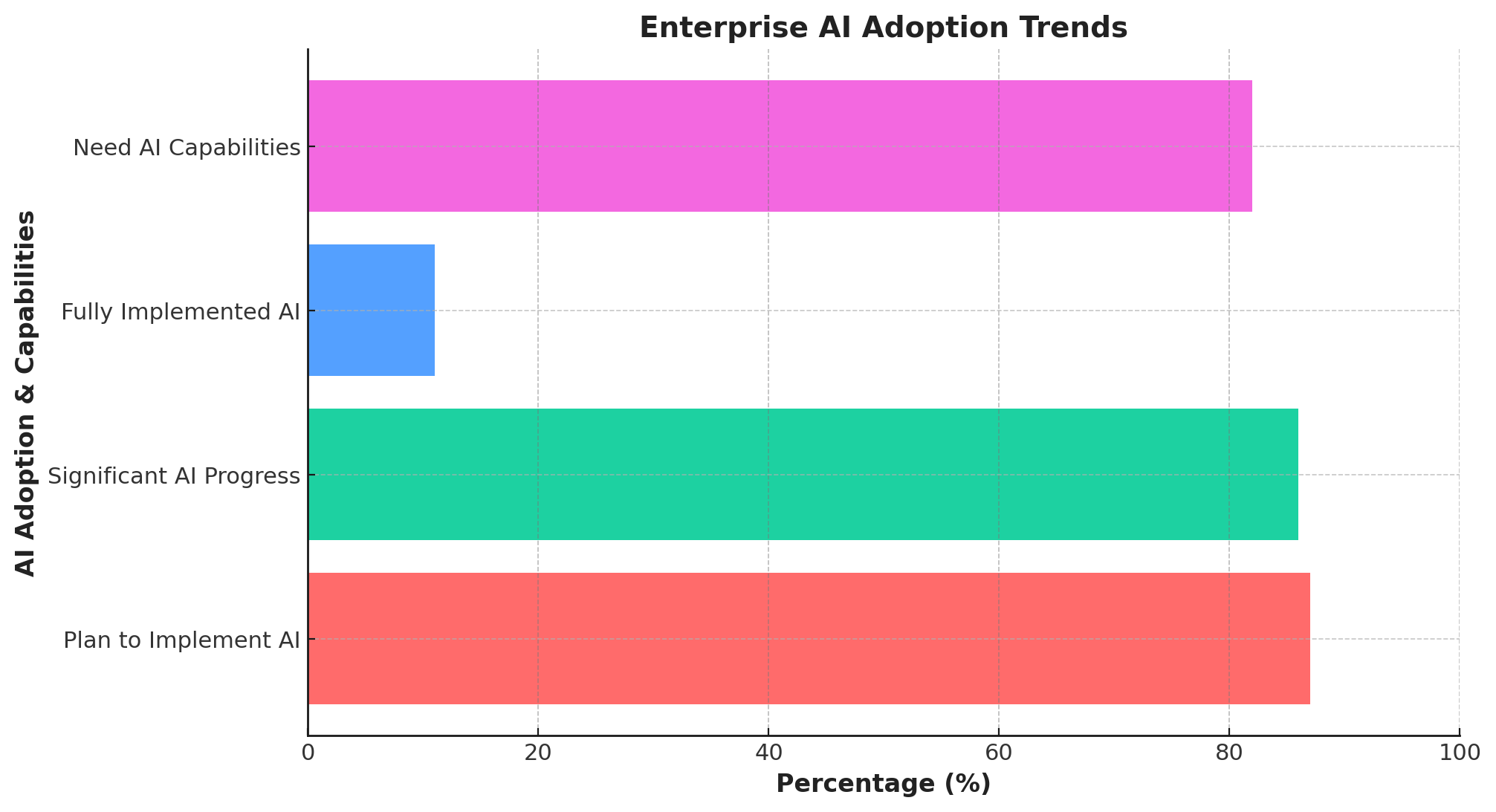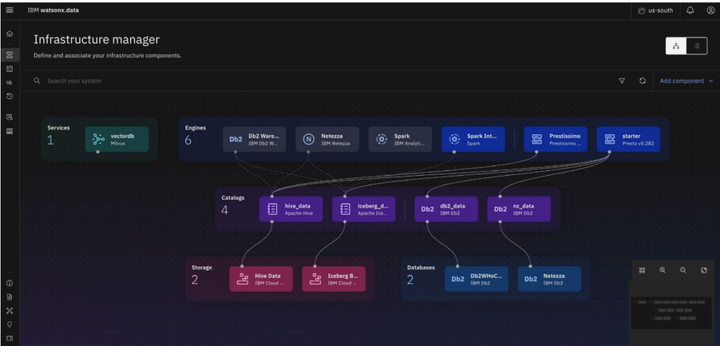How to Modernize Data Infrastructure for Generative AI

The New Data Imperative
Enterprise leaders today face a dual challenge: they must harness the power of artificial intelligence (AI) for real-time decision-making while also protecting sensitive data against a surge of security threats. With 87% of organizations eager to implement AI initiatives in the next 12 months, and 86% already making significant headway, the pressure to transform business operations through advanced analytics and AI is intense. Yet this urgency often collides with the reality of legacy data silos, complex regulatory requirements, and a wave of cyberattacks that exploited over 5.3 billion breached records in 2023 alone.[1]
As a leader, you want to enable your team to innovate, reduce costs, and sharpen competitive advantage. However, you might feel concerned—maybe even overwhelmed—by the complexity of securing diverse data sources while delivering immediate insights. You may ask: How can I simplify data access? Are current security measures enough to protect my most valuable data assets?
Rest assured, you’re not alone. In this guide, we’ll explore the key challenges, cutting-edge strategies, and real-world success stories that prove it’s possible to unify data access securely and tap into real-time analytics for meaningful AI-driven growth.
Untangling the Data Web: Core Challenges in Real-Time Analytics and Security
Complexity is the name of the game when it comes to enterprise data. Organizations are swimming in information from a vast array of sources—transactional databases, Internet of Things (IoT) sensors, mobile apps, cloud services, social media feeds, and more. What makes this environment even more daunting are the following challenges:
- Data Silos and Legacy Systems
Many enterprises rely on aging infrastructure that isolates data in departmental silos. Such fragmentation creates significant roadblocks to unified analytics. As a result, executives struggle to gain a single, consistent view of operations, making it difficult to respond swiftly to market shifts or emerging risks. - Surging Security Risks
The rise in AI adoption has coincided with an upsurge in data breaches, driven by sophisticated cybercriminals leveraging AI for malicious activities. With 5.3 billion records breached in 2023,[1] the stakes are colossal. Meanwhile, 91% of the public believes AI must be carefully managed, and 77% support security testing before AI product releases, underscoring a widespread demand for stronger safeguards.[2] - Mounting Regulatory Pressures
Governments worldwide are enacting stringent data privacy laws—think GDPR, CCPA, and HIPAA—to protect consumer information. Noncompliance can result in hefty fines, eroded brand trust, and, in extreme cases, legal action. Meeting these requirements is especially challenging when data is scattered across multiple on-premises and cloud environments. - Skills and Capabilities Gap
While 82% of leaders acknowledge the need to develop new capabilities for AI,[3] only 11% of CIOs have fully implemented AI solutions in their organizations.[4] Skilled data engineers, data scientists, and security experts are in high demand, but supply is limited. This shortage hampers an enterprise’s ability to unify data access efficiently and securely. - Fragmented Tooling
Even when organizations embrace modern data platforms and AI workflows, they often cobble together solutions from various vendors. The resulting patchwork is cumbersome and expensive, complicating data governance and limiting real-time visibility.
These challenges are significant but not insurmountable. Addressing them requires a combination of strategic thinking, robust technologies, and a cohesive approach to security that balances data accessibility with the imperative to protect sensitive information.
Building the Real-Time Engine: Strategic Insights for Simplifying and Securing Data Access
Successfully implementing real-time analytics and AI hinges on embracing a set of critical best practices. These foundational insights empower enterprises to transform their complex data landscapes into streamlined engines for innovation.
- Adopt a Data Fabric or Data Mesh Architecture
Emerging architecture styles—like data fabric and data mesh—break down silos by decentralizing and unifying data management. Data fabric creates a virtualized layer across disparate systems, whereas data mesh delegates data ownership to cross-functional teams. Both approaches establish a metadata-driven foundation, making data discoverable, consistent, and secure across the organization. - Elevate Data Literacy
Data literacy is emerging as a key factor for AI success, with 90% of IT professionals indicating that better data literacy and security practices significantly affect AI project outcomes.[5] This emphasis on education ensures that your workforce can responsibly manage, interpret, and utilize real-time data. AI literacy programs facilitate the correct usage of machine learning models and help employees mitigate risks tied to data misuse. - Integrate Data Security Posture Management (DSPM)
By 2026, more than 20% of organizations will deploy Data Security Posture Management technology,[6] underscoring the importance of proactive risk identification. DSPM solutions automate threat detection, classify sensitive data, and enforce compliance policies across multi-cloud environments in real time. - Leverage Real-Time Data Streaming
Real-time streaming platforms allow enterprises to ingest and process massive amounts of data as events unfold. By reacting instantly to user behavior, sensor readings, or transaction data, organizations can deliver personalized experiences, detect fraud, and take immediate action against security threats. For instance, leading financial institutions rely on data streaming to spot irregular transactions and mitigate fraudulent activities on the fly. - Strengthen Identity and Access Management (IAM)
Unified IAM tools—like Microsoft Entra—offer adaptive access control, dynamically adjusting user permissions based on behavioral signals. This reduces the risk of unauthorized access while enabling frictionless data availability for legitimate users. Strong IAM integrated with Single Sign-On can lower password fatigue and related security vulnerabilities.
By weaving these strategies into your data and AI roadmap, you can lay the groundwork for delivering real-time analytics without compromising on privacy or compliance. Next, we’ll explore how industry titans like IBM, Google, Amazon, OpenAI, and Microsoft are exemplifying these strategic insights.
Industry Powerhouses Paving the Way
When it comes to simplifying and securing data access, a handful of tech giants stand out for their forward-thinking approaches and commitment to innovation. Here’s how IBM, Google, Amazon, OpenAI, and Microsoft are each tackling the real-time data challenge.
- IBM: Unified Data Fabrics and Hybrid Cloud Prowess
IBM has invested heavily in data fabric solutions. For instance, IBM watsonx.data is built on an open lakehouse architecture designed to unify data lakes and data warehouses while supporting multiple query engines.[7] This approach aims to reduce duplication and ease the process of extracting insights from hybrid cloud environments. Its z16 system further integrates AI capabilities for real-time insights in transactional workflows—particularly critical for large-scale finance and retail applications. - Google Cloud: Continuous Intelligence and Secure AI Framework
Google Cloud’s Dataflow offers a unified model for both batch and stream processing, enabling organizations to analyze data in real-time and respond to events as they happen.[8] Meanwhile, Google’s Secure AI Framework addresses AI risk from the ground up, focusing on lifecycle governance and advanced threat detection. On the identity and access front, the company offers solutions like Google Cloud’s Pub/Sub service for large-scale event ingestion, combined with robust data governance features for compliance with regulations such as GDPR and HIPAA. - Amazon (AWS): Real-Time Analytics and Zero-ETL Integrations
AWS has invested in services like Amazon SageMaker Unified Studio, which streamlines data processing, SQL analytics, and AI development in a single environment. Solutions such as Amazon Kinesis enable real-time data streaming for fraud detection and user personalization at scale. With zero-ETL integrations, AWS simplifies data pipelines to accelerate analytics in real-time contexts. - OpenAI: Real-Time Retrieval and Enterprise Security
Known for language models like GPT-4, OpenAI extended its capabilities by acquiring Rockset—a move that bolsters real-time analytics for Retrieval-Augmented Generation (RAG) pipelines. The company also emphasizes data privacy by using advanced encryption and global regulation compliance to secure sensitive data. Its partnerships with Microsoft have further expanded secure cloud computing options for enterprise-grade AI applications. - Microsoft: Adaptive Governance and End-to-End Security
Microsoft Purview offers data security posture management tools, delivering real-time visibility into security risks that can hamper AI initiatives. Similarly, Microsoft Entra integrates adaptive access and single sign-on to streamline data access. Features like Purview’s integration with Azure Synapse Analytics unify governance for analytics workloads, ensuring robust data protection even as organizations scale AI solutions.
By learning from these tech leaders, enterprises can selectively adopt the best features suited to their unique environments, forging a path to simplified yet secure data access. Up next, we’ll look at real-life case studies where these innovations are translating into tangible success.
Lessons from the Trenches: Real-World Case Studies
Below are some concrete examples that demonstrate how forward-thinking companies are wielding modern data strategies to accelerate real-time analytics and enhance security.
Nsight: Breaking Down Data Silos for Performance Gains
- The Challenge: Nsight, a technology solutions provider, faced fragmented data silos that hindered accurate analytics and slowed decision-making.
- The Solution: By integrating AI-driven data management solutions, Nsight unified its disparate data sources, introducing real-time analytics and comprehensive governance.
- The Result: The company saw a 45% improvement in data accuracy and a 35% reduction in processing time, illustrating how modern data practices can significantly amplify operational efficiency.[9]
Beyerdynamic: Real-Time Reporting for Operational Agility
- The Challenge: Beyerdynamic, an audio equipment manufacturer, struggled with slow, manual reporting processes that led to delayed insights.
- The Solution: They implemented a real-time data warehouse, automating data extraction from enterprise resource planning (ERP) and financial systems. This integration laid the foundation for immediate data access and up-to-the-minute dashboards.
- The Result: The shift dramatically improved the accuracy and timeliness of sales reports, enabling the company to make data-driven decisions faster and more effectively.[10]
Amazon: Scaling AI to Personalize Customer Experiences
- The Challenge: Even a digital retail leader like Amazon sought to optimize inventory management and personalize marketing. Without reliable real-time data, forecasting demand and targeting promotions accurately were challenging at scale.
- The Solution: Amazon used real-time analytics to monitor inventory levels and customer interactions. Integration with AI models enabled personalized product recommendations, dynamic pricing, and faster supply chain adjustments.
- The Result: By aligning supply with real-time consumer demand, Amazon improved operational efficiency and boosted revenue, underscoring how data streaming and AI can fuel competitive advantage.[11]
Forcepoint: Automated Security Actions in Multi-Cloud
- The Challenge: With multi-cloud adoption, data security postures became difficult to manage. Forcepoint, an AI-based security provider, needed a robust, automated system to protect sensitive information across multiple environments.
- The Solution: Forcepoint’s AI-Based Data Security Posture Management (DSPM) solution automated risk remediation through real-time visibility. The platform continuously monitored data flows, identifying anomalies and taking preventative measures.
- The Result: Organizations using Forcepoint could respond to threats quickly while complying with regulations, demonstrating how DSPM’s proactive approach mitigates security lapses in fast-paced, multi-cloud contexts.
Each of these examples underscores the transformational impact of unified data access and robust security strategies, proving that streamlined data practices are not just theoretical but highly actionable in diverse industry settings.
A Practical Path Forward: Roadmap to Data Simplification and Security
Armed with insights and real-world evidence, the next step is translating aspiration into actionable tactics. Below is a roadmap to help enterprise leaders integrate simplified data access and airtight security into their organizational DNA.
- Conduct a Comprehensive Data Audit
Start by cataloging data sources across your enterprise—from on-premises systems to public cloud services. Identify sensitive information subject to regulatory mandates like GDPR or HIPAA. This initial step clarifies your data landscape and points to any existing vulnerabilities. - Prioritize Real-Time Workloads
Not all data requires immediate processing. Pinpoint high-value use cases—such as fraud detection, real-time promotions, or live operational dashboards—and focus on building streaming pipelines for these tasks. Services like AWS Kinesis, Google Cloud’s Dataflow, or IBM’s data fabric solutions can handle large-scale ingestion and streaming analytics. - Implement Adaptive Security Controls
Strengthen your identity and access management strategy by investing in tools that adapt permissions dynamically. Microsoft Entra, for instance, continuously evaluates user contexts (location, device, usage patterns) to minimize security risks. Combine this with advanced encryption—both in-flight and at-rest—to protect data wherever it resides. - Adopt Data Security Posture Management (DSPM)
With more than 20% of organizations expected to adopt DSPM by 2026,[6] it’s poised to become a cornerstone of modern security infrastructure. DSPM platforms can automatically categorize data, detect misconfigurations, and enforce consistent policies across multiple clouds. This helps reduce human error and speeds up compliance checks. - Integrate AI for Automated Insights
Employ AI capabilities throughout the data lifecycle—from automated data ingestion and cleaning, to anomaly detection and predictive analytics. Platforms like IBM watsonx.data or Amazon SageMaker come with built-in AI workflows that help you glean actionable insights without cobbling together multiple disparate tools. - Upskill Your Workforce
Since 82% of leaders already see a critical need for new AI-related capabilities,[3] develop training initiatives that cover AI best practices, data security, and compliance. Encouraging data literacy at all levels of the organization fosters a culture where teams can make informed, responsible use of real-time analytics. - Run Pilot Projects Before Full Deployment
Rather than overhauling your entire data ecosystem in one go, run pilot programs in a specific business unit or function. Evaluate ROI, document lessons, and refine processes. This iterative approach minimizes disruption while building organizational confidence. - Monitor, Measure, and Iterate
Finally, treat data management and security as ongoing endeavors. Implement continuous monitoring, track metrics around data quality and breach attempts, and stay current with evolving threats. Regular audits and updates to your data governance framework ensure sustained success.
By systematically following these steps, you build a robust foundation for real-time analytics and AI, without sacrificing the security and privacy of critical data assets.
Charting Tomorrow’s Data Destiny
The path to simplified, secure data access might seem convoluted at first, especially with ever-evolving risks and a landscape rife with regulatory complexities. Yet the payoff is unequivocal: immediate, data-driven insights that can revolutionize your decision-making, tighten your security posture, and differentiate your organization in a competitive market.
Whether you’re refining an existing data strategy or starting from scratch, you have an array of proven architecture patterns, tools, and best practices at your disposal. Real-time streaming, AI-driven data governance, and DSPM solutions collectively form a blueprint for success. The case studies of Nsight, Beyerdynamic, and Amazon exemplify what’s possible when leaders prioritize an integrated, secure approach to analytics.
As you look ahead, keep in mind that this journey isn’t a one-and-done undertaking. It requires continuous assessment, workforce training, and iterative improvements. The ultimate goal remains clear: remove data bottlenecks, maintain ironclad security, and unleash the full power of AI to transform your business processes. By following the strategies outlined here, your organization will be well-positioned to harness real-time intelligence—and do so confidently.
Join the Data & AI Leaders Circle
If you’re ready to deepen your expertise, stay on top of the latest industry trends, and network with other forward-thinking leaders, consider joining my newsletter. Each week, I share exclusive insights, detailed case studies, and practical how-to guides—all designed to help you make better, faster, and more secure data-driven decisions.
Click here to subscribe and let’s continue to build a future where data empowers, protects, and propels our organizations forward.
References
- https://www.dataversity.net/7-data-security-best-practices-for-your-enterprise/
- https://wiki.aiimpacts.org/responses_to_ai/public_opinion_on_ai/surveys_of_public_opinion_on_ai/surveys_of_us_public_opinion_on_ai
- https://blog.dataiku.com/the-abcs-of-ai-literacy
- https://www.salesforce.com/news/stories/cio-ai-trends/
- https://techstrong.ai/articles/real-time-hybrid-data-access-and-security-needed-for-ai-success/
- https://techcommunity.microsoft.com/blog/microsoft-security-blog/strengthen-your-data-security-posture-in-the-era-of-ai-with-microsoft-purview/4298277
- https://www.ibm.com/products/blog/exploring-the-ai-and-data-capabilities-of-watsonx
- https://cloud.google.com/dataflow
- https://www.nsight-inc.com/nsight-resources/ai-driven-data-management-a-case-study-in-transforming-business-operations/
- https://estuary.dev/real-time-data-warehouse-examples/
- https://klikanalytics.co/data-analytics-real-world-examples/

